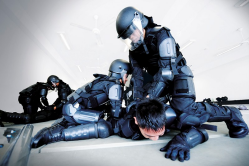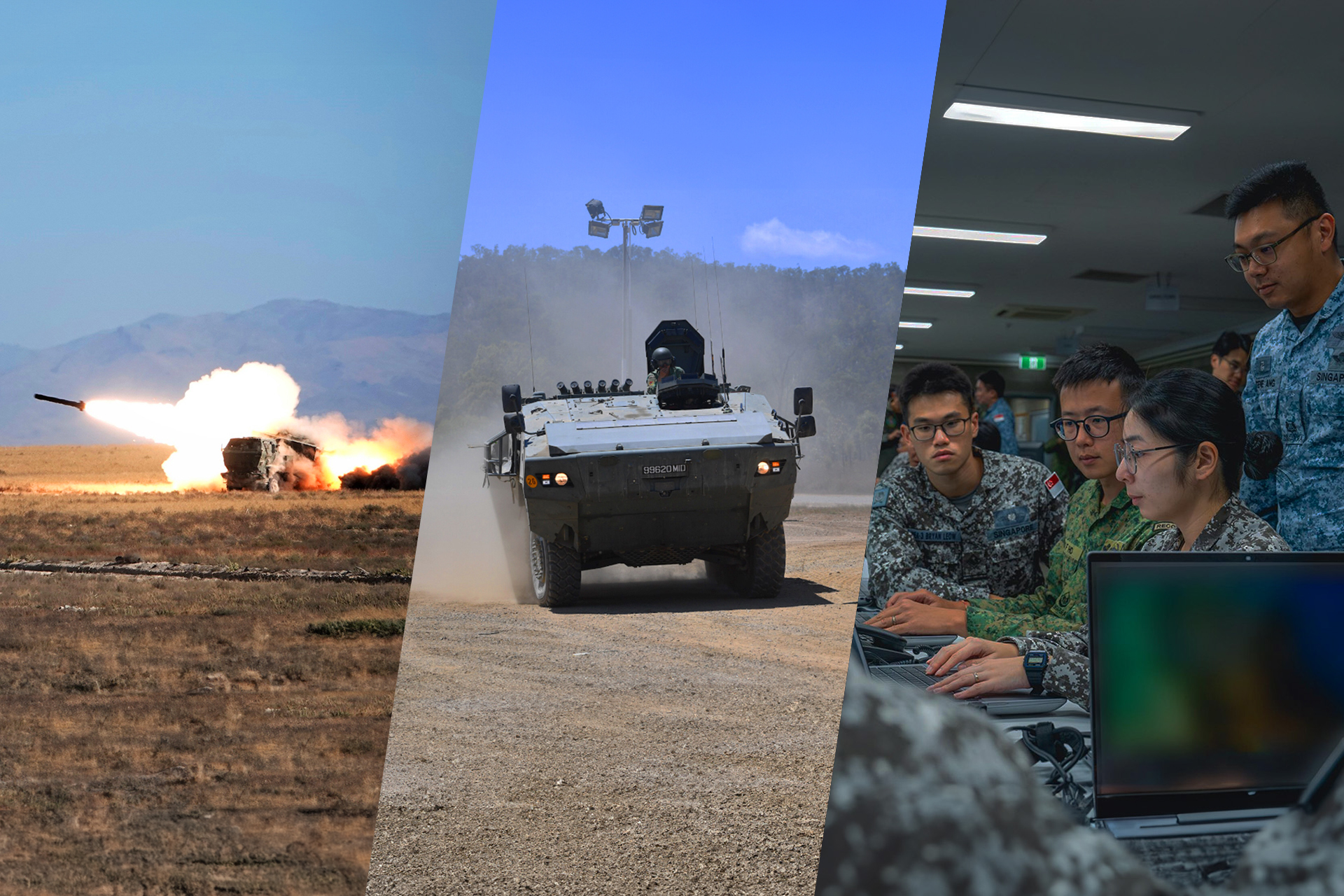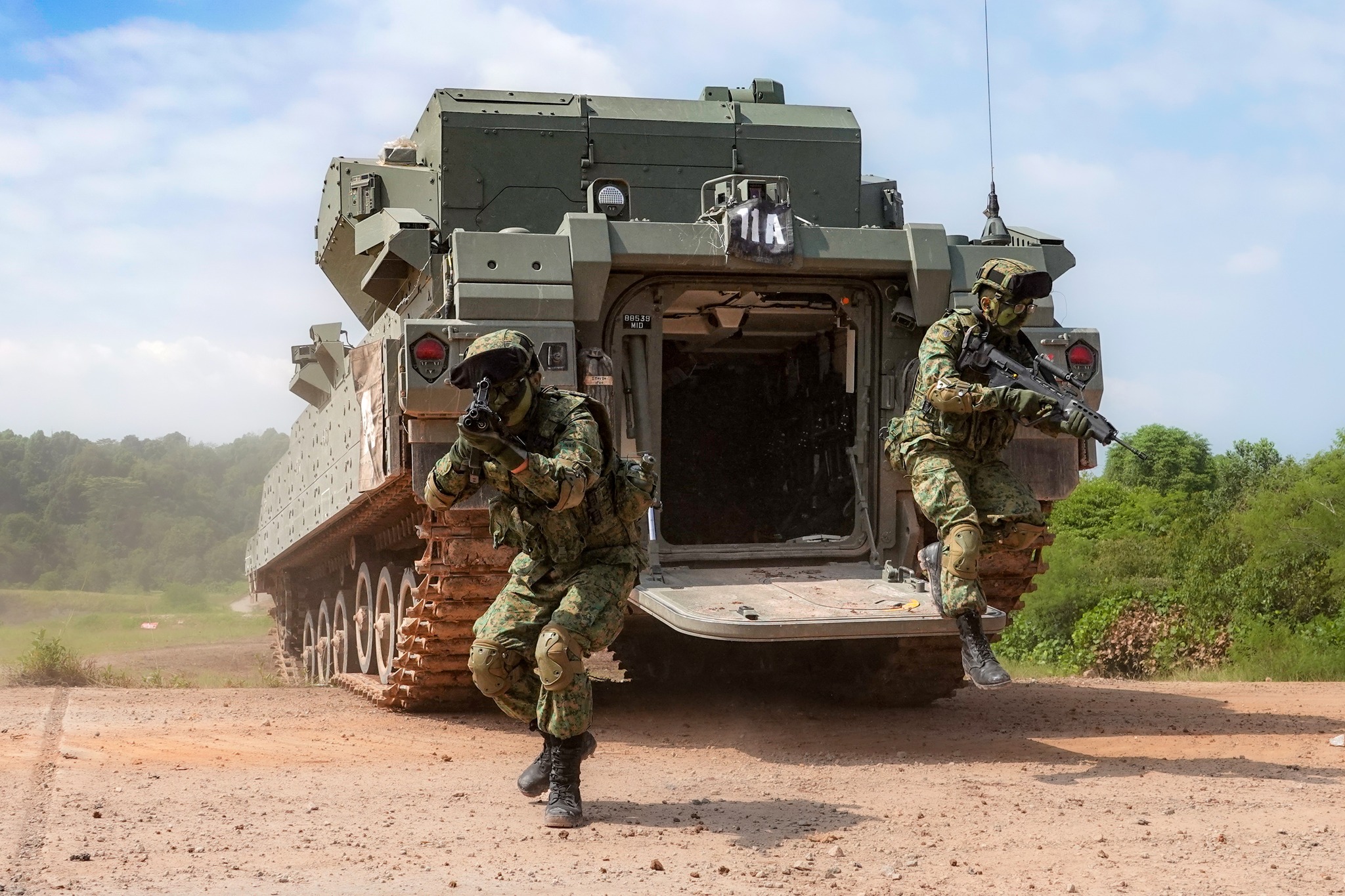MILITARY MATA-MATA
PHOTO // PIONEER Photographers
You may only know them for the security checks they do before you are allowed into military camps and for enforcing military law should you try to be funny. But the soldiers of the Singapore Armed Forces (SAF) Military Police (MP) Command do all that and more. Read on to find out.
Spot checks. Camp security. Istana guards.
These are some of the things that usually come to mind whenever the SAF MP Command is mentioned.
Armed with policing powers, this specialised group of servicemen has grown in capabilities since becoming a Command in September 2006. Today's MP can carry out various roles in areas such as anti-riot operations, the ceremonial Guard-of-Honour (GOH) contingent, traffic policing and even the protection of Service chiefs.
"We are the equivalent of the Police in terms of military law," said Lieutenant Colonel (LTC) Chan Choon Meng, the former Commanding Officer (CO) of the Military Police Enforcement Unit (MPEU) and current Head of the Special Investigations Branch (SIB).
Since January 2012, the SAF MP Command has expanded to include the Gombak Base unit and 8th Battalion, Singapore Infantry Regiment (8 SIR), which are responsible for the protection of SAF camps, as well as 9 SIR, which is in charge of protecting civilian key installations.
Explaining the rationale for the restructuring, Colonel (COL) Ong Chia Choong, Commander of SAF MP Command, said: "8 SIR, for example, is in charge of camp security and they are the first point in managing security as well as enforcing discipline.
"And because MPs have greater powers of enforcement than any other vocation, it (the restructuring) strengthens the security and discipline enforcement in SAF camps."
Also riding on the restructuring was the SAF Band. With its constant partnership alongside the ceremonial GOH contingent in SAF-related events, the band was brought in to strengthen the working relationship between the two.
These are just a few examples of the growth and changes the SAF MP Command has undergone since its formation in 1966. Here's a look at how the Command has evolved to deal with emerging threats, all while upholding their role as the core law enforcement body of the SAF.
Training
Becoming an MP
Close combat is one of the modules which MP trainees have to go through during MPTS.
Click to view GalleryWhen a trainee fresh out of the Basic Military Training Centre (BMTC) gets posted to SAF MP Command, it is essential that he goes through the Basic MP course - a nine-week programme conducted by the MP Training School (MPTS) - before he is recognised as a full-fledged MP.
To be an MP, a trainee must first know his rights. Part of an MP's job is to arrest suspects, so he must be able to justify doing so. Thus, modules such as law and order, legislation and enforcement are taught in the Basic MP course. Armed with this knowledge, the MP will know when he has the right to search and arrest people or even seize items from them.
To help them deal with physical conflicts that may arise during such situations, modules like close combat training, search and arrest and self defence come into play. While such training is largely similar to what regular soldiers would learn, the main thing that differentiates MP trainees from others is their choice of weapon - the P226.
Weighing a mere 964g, the P226 is used as a sidearm by MPs. As MPs are usually engaged in close-quarters situations, such as sentry duties and close protection operations, the lightweight and compact weapon allows them to draw their guns faster, compared to being armed with rifles like the Singapore Assault Rifle 21.
The trainees undergo basic instructions on how to operate the weapon before they proceed to live firing. Scenario-based training is also conducted to hone their judgement and test their ability to respond to different situations.
Once trainees complete the nine-week basic course, they will be posted to the various sub-units, including MPEU and SAF Detention Barracks (DB), where they will continue to learn specialised skills for their roles in the respective units.
"The outcome of any trainee who goes through the course is to become a professional and respected MP. They must know their rights, understand their roles and be firm. That's when they will earn the respect of others."
- Senior Warrant Officer (SWO) Ger Ah Kee, CO MPTS
Enforcement
The law enforcers
''Rioters'' (right, in No. 4 fatigues) played by fellow MPs have no qualms about giving the anti-riot team a tough fight in preparing them for real-life situations.
Click to view GalleryAs its name implies, the MPEU is the main enforcement arm of the SAF MP Command. MPs who are trained under this unit are equipped with specialised skills to take up enforcement roles required to maintain military discipline in the SAF.
The MPEU consists of two companies, the Law Enforcement and Ceremonial Company (LECC) and the Support Company.
MPs from the latter play roles such as the guarding of the Istana and traffic policing. MPs from the former conduct spot checks in SAF camps and bases as well as on vessels and servicemen returning from overseas operations and training. Together with their military working dogs, the MPs would conduct checks for contraband items. Any suspicious items found would be seized. On top of these enforcement operations, they also carry out ceremonial duties such as forming the GOH contingent at the Istana.
Control, restrain, detain
To detain and control personnel who have gone AWOL (Absent Without Official Leave) as well as rioters within camps, MPs have to undergo the anti-riot training programme. Decked in black polymer-plastic suits from head to toe, and carrying their batons and shields, these guys are not to be trifled with.
"If a riot occurs on SAF premises, we are the first response force," said Lieutenant (LTA) Jeremy Bin.
The Platoon Commander 1 from LECC explained that under the programme, MPs learn control and restraint (C&R) techniques, which is the main method used to subdue rioters. This training could come in handy even during spot checks in camps, when MPs may encounter "non-compliant" servicemen who might turn aggressive.
"For passive rioters, we use C&R techniques as we can moderate the amount of force we use so that we won't injure them. For more aggressive ones, like those throwing rocks and benches, we would usually employ a technique called the baton charge.
"It's basically charging in with our batons and then using C&R techniques to detain and take the rioters away," elaborated LTA Bin.
Specialised support
While the LECC MPs cover law enforcement, those from the Support Company are organised for more diversified roles and comprise five platoons.
The first is the Presidential Guards Platoon which performs ceremonial operations at the Istana. Then there is the Escort and Processing Office (EPO) which is in charge of processing detainees prior to entering the SAF DB.
The third is the Silent Precision Drill Squad (SPDS) in which the MPs train at twirling and tossing their 5kg Mark IV rifles in the air with immaculate precision and coordination. The squad performs at major events such as Open Houses, the monthly Changing of Guards (COG) ceremony, and National Day Parades.
The Traffic Platoon, or outriders as they are commonly known, enforces discipline and traffic safety the same way as the traffic police do. The only difference is that their eyes are trained on SAF vehicles and servicemen who go against traffic regulations.
On top of looking out for vehicles, the outriders also take on escorting roles in the event of heavy SAF vehicles such as the Terrex Infantry Carrier Vehicle moving on the open road.
Lastly, hailing from the Special Security and Protection (SSP) unit is a band of skilled protectors. Consisting of all Regulars, this group goes through special martial arts and defensive driving training to help ensure the safety of key personnel in the SAF and Ministry of Defence (MINDEF).
Like the police, the SAF also has its own investigation branch. The SIB possesses its own in-house Crime Scene Investigative capabilities to uncover the truth. The cases are then passed on to MINDEF Legal Services for further action.
As for the SAF DB, it is the only incarceration facility for military offenders. In recent years, the unit has worked together with the SAF Counselling Centre and volunteers to enhance its rehabilitation efforts. These programmes allow detainees to integrate more quickly into society and their units upon their release.
"If a riot occurs on SAF premises, we are the first response force."
- LTA Jeremy Bin, Platoon Commander 1, LECC
Security
Watching over the SAF
Together with 9 SIR, the MPs guard civilian key installations.
Contrary to common belief, the SAF MP Command is not an Army unit. As a tri-Service unit, it also deploys MPs to provide security at naval and air force bases.
For 8 SIR, 9 SIR and the Gombak Base unit, which came under the ambit of SAF MP Command a year ago, the transition was beneficial to all parties involved.
Beefing up camp security operations in terms of authority and discipline was one of the major benefits reaped from the merger.
"The presence of MP specialists has made a lot of difference," said LTC Joshua Gopal Sundram. The CO of 8 SIR was referring to MP specialists who now take on the role of Access Control Force (ACF) commander to 8 SIR's security troopers in all access control points in camps.
Every quarter, the SAF MP Command deploys about 50 MP specialists to 8 SIR, where most of them become commanders to the security troopers in camps and bases. A handful are also situated within 8 SIR to conduct courses for the security troopers to ensure that what they learnt back in MPTS is passed on.
"With MPs on the ground, they ensure that things are done with the proper procedures and the military law (in place)... At the same time, these guys help my security troopers to ensure discipline and regimentation at the front line," said LTC Joshua.
Ceremonial
With pride and precision
Famous for their swift and precise rifle drills, the SPDS never fails to wow the crowd every time they perform.
Click to view GalleryThe catchy tunes of the SAF Central Band can be heard in the Somerset area once a month, along the road leading to the Istana. The SPDS leads the parade, wowing the crowd with its swift and precise twirling of rifles to a synchronised beat. Without batting an eyelid, the MPs toss their rifles in the air and catch them easily, giving the crowds more reason to cheer.
The squad is closely followed by the band, whose tunes match the deft actions of the SPDS. Lastly, the GOH contingent marches swiftly to the entrance of the Istana, where spectators would have already formed up against the barricades.
Held on the first Sunday of every month, the 30-minute display showcases a significant military ceremony - the COG.
"The first time I went out onto the streets, everyone started taking out their smartphones to take photos of us. Then the nervousness kicked in and I realised that I couldn't make a mistake," recalled Lance Corporal (LCP) Koh Kai Wei.
The Auxiliary Instructor for SPDS explained that it was tough keeping up his concentration and staying focused on his performance when he first participated in the COG ceremony. If anyone made a mistake such as dropping his rifle during the drills, they were trained to react calmly and not cause any further disturbance to the performance.
"We have to make it look like a drill. So we squat down slowly, pick the rifle up and go back to slope arm position where we hold the rifle by our side. And when the next drill comes in, we will join the rest."
LCP Koh and his team might make the drills look easy, but their flawless execution comes with long hours of practice and endurance. With daily practice sessions and the rifles weighing about 5kg each, wrist injuries are a real danger if they perform a drill wrongly.
"The Basic SPDS course consists of rifle physical training, getting used to the weight of the rifle and training up your physical strength. Teamwork is also crucial - we learn to count with each other, making sure that we are synchronised," explained LCP Koh.
After the one-month basic course, a handful would be selected to join the SPDS where they learn choreography through the advanced course such as jumbo (two hands tossing the rifle into air) and double jumbo. The SPDS also learns how to plan for the COG and further enhance their teamwork.
Despite being a diversified unit, the SAF MP Command is still, first and foremost, the key law enforcer of the SAF. With the MPs more than equipped with their skills and training, the SAF will continue to stay safe and secure under their vigilant eye.
"The first time I went out onto the streets, everyone started taking out their smartphones to take photos of us. Then the nervousness kicked in and I realised that I couldn't make a mistake."
- LCP Koh Kai Wei, Auxiliary Instructor, SPDS










